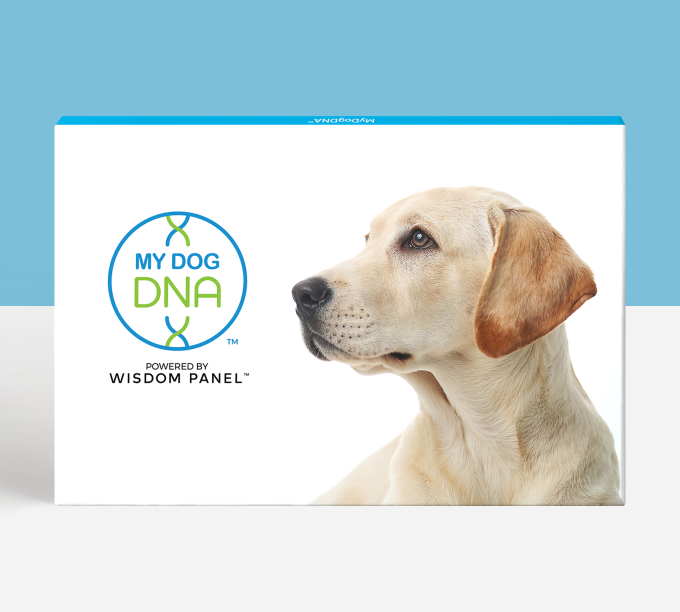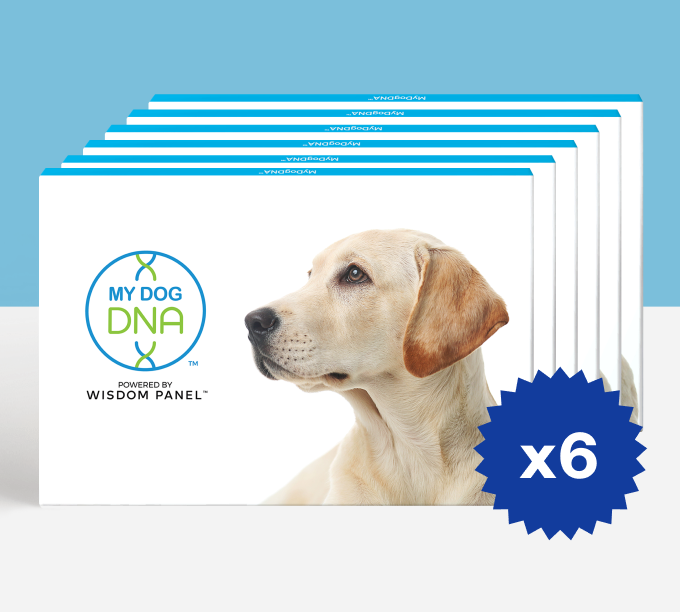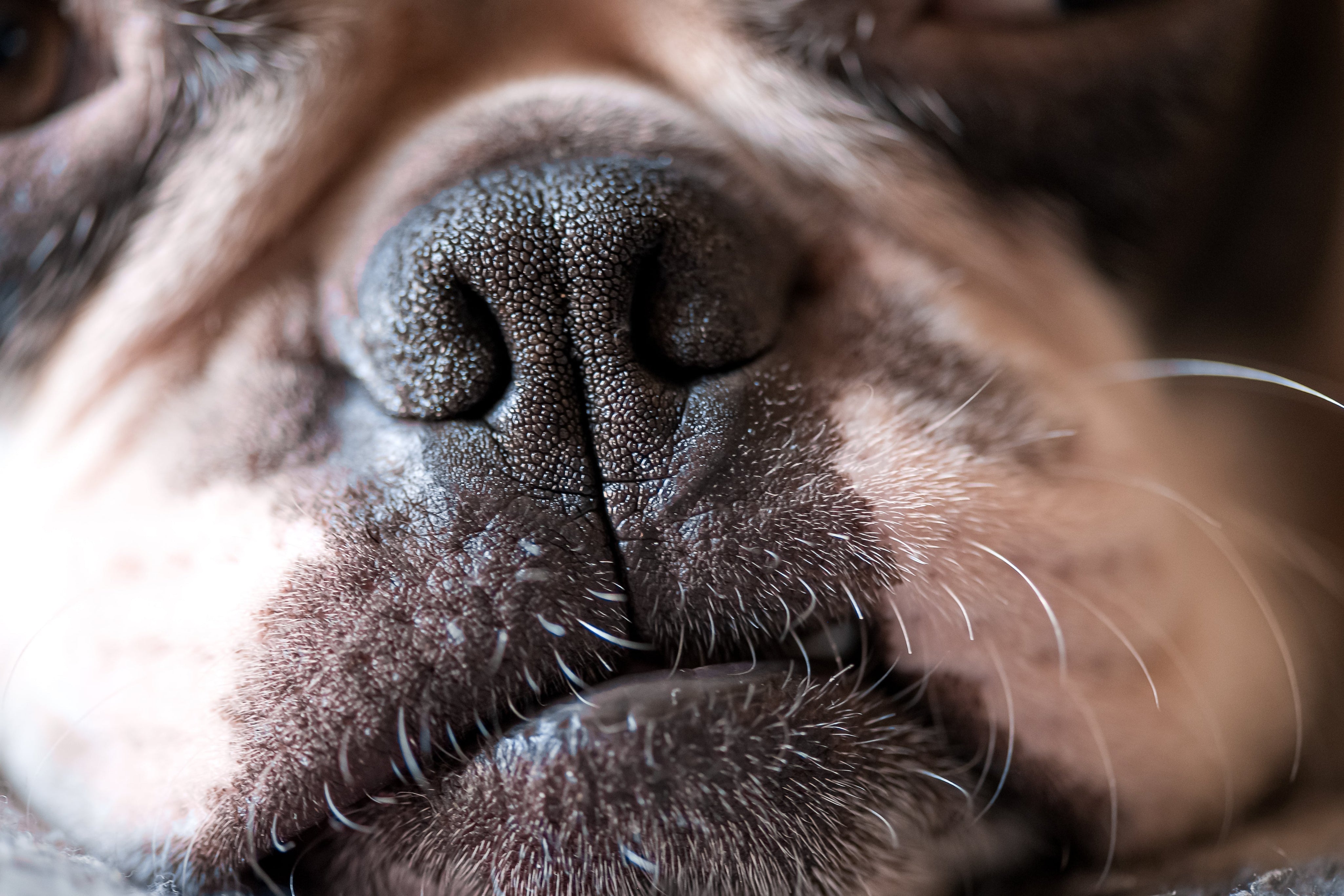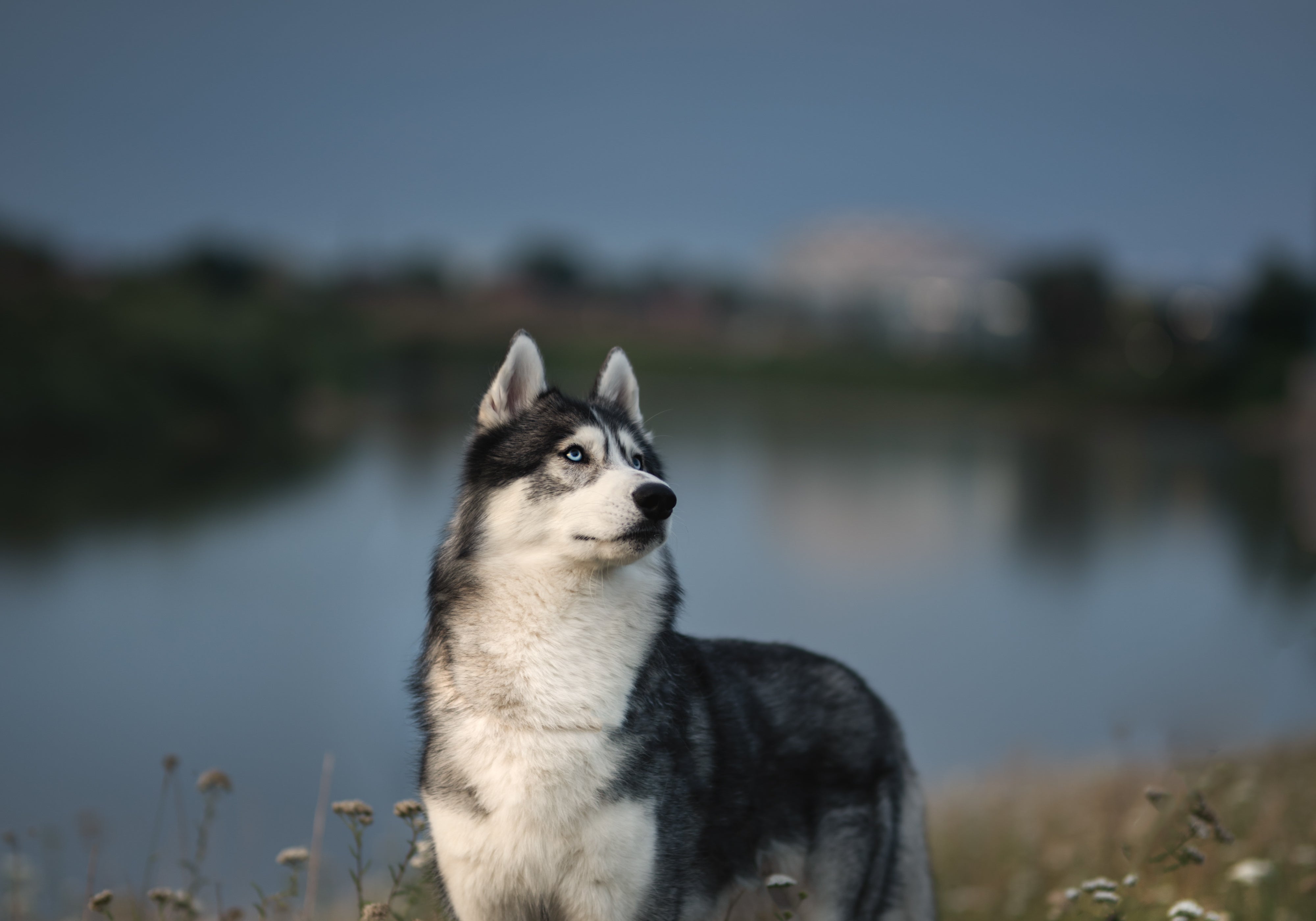Snub-nosed dogs and cats are characterised by a shortened muzzle and skull called brachycephaly; this face shape is seen in a number of breeds, but notably in three breeds growing rapidly in popularity: French Bulldogs, English Bulldogs, and Pugs. In cats, the Persian and Burmese are also known for brachycephaly. Many historic companion and guardian breeds have this face shape, but the degree of shortening has increased significantly in the last 50 years. This increase in shortening has led to the identification of an associated disease syndrome and a new method of measuring presence and severity of breathing difficulties. For breeders, understanding potential risks, testing options, and prevention strategies is key to preserving the health and well-being of their breed.
What is brachycephaly?
The term ‘brachy’ and ‘cephaly’ together mean ‘shortened head,’ referring to the shortened front-to-back length of the head as compared to wild canids. This head shape occurs in a range from mild brachycephaly such as that seen in the Cavalier King Charles Spaniel and Border Terrier, to the pronounced shortening seen in the Pekingese and Griffon Bruxellois (Brussels Griffon). The following are some of the best-known “brachy” breeds:
- French Bulldog
- English Bulldog
- Pug
- Boston Terrier
- Shih Tzu
- Boxer
What is BOAS?
Extreme brachycephaly has significant side-effects; most notably, difficulty breathing. With the selection for markedly shortened muzzles, other facial structures changed as well, and veterinarians noted that these abnormalities tend to block normal airflow from the nose down to the lungs. These clinical features tend to co-occur, with some variation by breed. Interestingly, some breeds with significant brachycephaly do not commonly show BOAS, while other breeds frequently do. Currently, French Bulldogs, English Bulldogs, and Pugs have been identified to have the highest rates of BOAS. The collection of abnormalities associated with a snub nose was termed brachycephalic obstructive airway syndrome or BOAS, and includes:
- Narrowed nostrils
- “Crammed” sinus cavities
- Abnormally small windpipe (trachea)
- Elongated and thickened soft palate
- Elongated or enlarged tongue
- Secondary changes, including airway collapse
Chronic difficulty breathing strains the structures of the airway, leading to swelling, irritation, and eventually, changes like everted laryngeal saccules and laryngeal collapse, which could cause respiratory distress, collapse, or death. Because dogs with BOAS cannot breathe efficiently, they tend to be exercise intolerant and are not able to regulate their body temperature as well by panting, leaving them more susceptible to heat stroke.

What are the signs of BOAS?
Some breeds have a high rate of brachycephalic obstructive airway syndrome (BOAS), and pronounced brachycephaly, leading to the misconception that this is normal in the breed. However, all dogs should be able to breathe efficiently as a matter of basic wellbeing, regardless of breed, so what is common in the breed may not be a good indicator in all cases. Some signs that could indicate BOAS is present:
- Noisy breathing (breathing should be silent unless the dog is exercising heavily)
- Narrowed nostrils (stenosis)
- Excessive flatulence
- Snoring or obstructive sleep apnea
- Heat intolerance
- Changes in mucous membrane colour with activity (cyanosis)
- Unwillingness to run or exercise for more than short periods
What causes brachycephaly?
Although canine face shape is genetically complex, there are three genes known at this time to more strongly influence the degree of brachycephaly seen, which is associated with BOAS:
- SMOC2 on chromosome 1
- BMP3 on chromosome 32
- DVL2 on chromosome 5
SMOC2 and BMP3 testing are available as part of standard trait testing with MyDogDNA™ and Optimal Selection™ Canine. Although brachycephalic dogs with these variants are at higher risk of BOAS, not all snub-nosed dogs have BOAS.
Guard breeds like the English Bulldog and Boxer were bred to have a slightly longer lower jaw (mandible) relative to the upper jaw and a broad muzzle to create a stronger bite grip, and this may have led to the enhancement of brachycephaly and associated variants in these breeds. Brachycephaly also changes the face shape of the dog to be more juvenile in appearance with prominent eyes, which is postulated as the cause for its frequency in companion breed dogs like the Pug, Japanese Chin, or Tibetan Spaniel.

Screw-Tailed Breeds
DVL2 causes what is called ‘Robinow Syndrome’ in humans, and occurs with high frequency in French Bulldogs, English Bulldogs, and Boston Terriers, also called ‘screw-tailed’ breeds. It is likely a significant contributor to the brachycephaly seen in them, but DVL2’s relationship to BOAS risk is not clear. Additional breeds with variable rates of DVL2 mutations include the American Staffordshire Terrier, Staffordshire Bull Terrier, Dogue de Bordeaux, Olde English Bulldogge, and American Bulldog. DVL2 appears to be recessive in inheritance, and causes a number of changes:
- Shortened muzzle
- Broad head
- Widely set eyes
- Short stature
- Vertebral malformations
- Kinked tail (screw tail)

How is BOAS measured?
RFGS:
In order to breed away from BOAS, a reliable means of measuring severity is necessary. The Department of Veterinary Medicine at the University of Cambridge has developed the most popular method of measuring BOAS severity, called the respiratory function grading scheme (RFGS) score. Scoring is carried out by trained, RFGS-certified veterinarians, and consists of three or four parts with a standardised scoring sheet:
-
A short health survey (US)
-
A brief physical exam with auscultation of the airway (larynx) while the dog is calm
-
A three-minute brisk walk or trot at approximately 6.5-8 KPH (4-5 MPH). This walk is not designed to test the dog’s maximum speed, but is enough to cause increased breathing noise in BOAS-affected dogs
-
A brief post-exercise auscultation of the airway (larynx) to compare to the pre-exercise baseline.
RFGS scores range from 0-3, with a 0 score meaning no evidence of BOAS. In the UK and EU, trained veterinarians are available at many dog shows, clinics and events to provide scoring, and in some breeds and countries, scores above 0-1 (no clinical signs of BOAS) are banned from showing to encourage breeding for health. In the US, the Orthopedic Foundation for Animals (OFA) provides training and certification in RFGS, and provides a list of veterinarians available for scoring. Typically, scores are only considered official if the dog is over 12 months of age, and depending on the score and the breed, repeat tests may be recommended to check for changes.
VDH-Fitnesstest
The German Kennel Club or VDH also offers a BOAS evaluation developed by the Hannover Veterinary School called the VDH Fitnesstest. This test involves an initial exam, an observed run on a treadmill for 15 minutes at a speed appropriate for the dog’s size and health condition with two stops to check breathing, and a 15 minute recovery time after the run. Heart rate is continuously monitored during the treadmill test, and the whole evaluation lasts approximately 90 minutes total.
WBBP:
Another non-invasive method less commonly available for evaluation of respiratory function is called whole-body barometric plethysmography (WBBP). WBBP requires a specialized transparent chamber that is capable of measuring changes in air pressure. Dogs to be evaluated spend 30 minutes in the chamber without sedation to evaluate their respiratory function. The resulting respiratory waveforms can be evaluated for abnormality and severity using a proposed BOAS Index, on a scale of 0-100%.

Does BOAS come with other health risks?
Yes, BOAS appears to be associated with several other health conditions. Recent white papers by Nationwide® pet insurance report a much higher incidence of several diseases in brachycephalic breeds, which are worse in what they termed “extreme brachycephalic breeds,” defined as French Bulldogs, English Bulldogs, and Pugs. Extreme brachycephalic breeds with BOAS had the highest relative risk of several disease categories, including:
- Gastrointestinal disease
- Pneumonia
- Oesophageal disease
- Spinal disease
- Heat stroke
- Diseases of the eyelid
Treating and Managing BOAS
If you already have a dog suffering from BOAS, make sure they are not overweight or obese, as this will worsen signs of BOAS. Additionally, take measures to ensure your dog does not overheat in warm weather. There are several surgeries that may help correct some of the abnormalities associated with BOAS, depending on the severity:
-
Soft palate surgery: soft palate shortening (resection) or thinning (palatoplasty) so that the palate does not extend down the windpipe
-
Nose surgery: modification of the nostrils (wedge resection) or the immediate opening behind them (alar fold resection) to open the airways
-
Nasal passageway surgery: removal of tissue in crowded nasal passageways (laser-assisted turbinectomy (LATE))
-
Larynx surgery: removal of everted laryngeal saccules or removal of part of the cartilages of the collapsed larynx (laryngoplasty) or removal of everted and enlarged tonsils. In severe cases, more advanced surgeries may be needed.
Preventing BOAS
Surveys of pet owners show that they generally prefer dogs with some muzzle length to those with a near-vertical facial profile if given the choice, so there is demand for longer snouts. If you are a breeder of a traditionally brachycephalic breed, you can breed for health and pet owner preference by breeding for a moderate muzzle length, open nostrils, less wrinkling and greater athleticism. By breeding dogs with less brachycephaly, you can make a huge difference in the incidence of BOAS in your lines and improve your dogs’ ability to breathe normally. The Continental Bulldog, although developed through crossbreeding, is an excellent example of a breed with a healthy degree of brachycephaly while still retaining the “bully” look.
You may choose to complete RFGS scoring for your dogs, post the results to your kennel club or health registry to raise awareness, and avoid breeding dogs with scores of 2 or 3. The University of Cambridge and Royal Kennel Club have a helpful chart of relative risks in puppies depending on the scores of the parents, here. If you voluntarily use RFGS and make breeding decisions guided by it, this additional health testing is a way to promote your kennel and your commitment to your breed’s wellbeing.
You may also encourage your club to learn more about BOAS, and consider codifying safeguards against extreme brachycephaly into the breed standard. Clubs and registries could consider incorporating RFGS or similar into show or breeding incentives as the Royal Kennel Club and others have done. This sends a clear message to the public that the purebred breeding community is committed to breeding the healthiest dogs possible.
Ideally, a genetic test for BOAS and its severity would be developed so the syndrome could be avoided entirely without the need for additional testing, but research is ongoing as to the genetic relationship between brachycephaly and BOAS. Wisdom Panel™ is committed to research of this type as part of our dedication to the wellbeing of pets.
References:
BOAS Recognition and Diagnosis. Department of Veterinary Medicine University of Cambridge. https://www.vet.cam.ac.uk/boas/about-boas/recognition-diagnosis#WBBP. Retrieved 22 May 2025
Schoenebeck JJ, Hutchinson SA, Byers A, Beale HC, Carrington B, Faden DL, Rimbault M, Decker B, Kidd JM, Sood R, Boyko AR, Fondon JW 3rd, Wayne RK, Bustamante CD, Ciruna B, Ostrander EA. Variation of BMP3 contributes to dog breed skull diversity. PLoS Genet. 2012;8(8):e1002849. doi: 10.1371/journal.pgen.1002849. Epub 2012 Aug 2. PMID: 22876193; PMCID: PMC3410846.
Mansour TA, Lucot K, Konopelski SE, Dickinson PJ, Sturges BK, Vernau KL, Choi S, Stern JA, Thomasy SM, Döring S, Verstraete FJM, Johnson EG, York D, Rebhun RB, Ho HH, Brown CT, Bannasch DL. Whole genome variant association across 100 dogs identifies a frame shift mutation in DISHEVELLED 2 which contributes to Robinow-like syndrome in Bulldogs and related screw tail dog breeds. PLoS Genet. 2018 Dec 6;14(12):e1007850. doi: 10.1371/journal.pgen.1007850. PMID: 30521570; PMCID: PMC6303079.
Respiratory Function Grading Scheme Overview. Orthopedic Foundation for Animals. https://ofa.org/diseases/rfgs/. Retriever 22 May 2025
Brachycephaly in Canis lupus familiaris (dog). OMIA - Online Mendelian Inheritance in Animals, University of Sydney. https://omia.org/OMIA001551/9615/. Retrieved 22 May 2025.
Santos TI, Guerra DML, Santos GVC, Doiche DP, Oliveira FS. Anatomical differences of the cervical esophagus in brachycephalic dogs. Morphologie. 2025 May 1;109(366):100968. doi: 10.1016/j.morpho.2025.100968. Epub ahead of print. PMID: 40315622.








